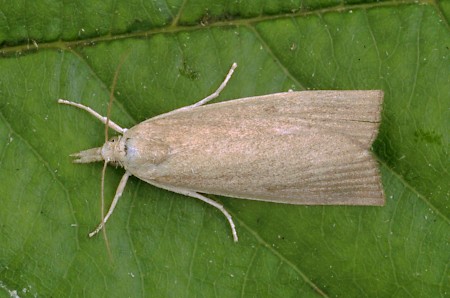63.079 BF1292
Calamotropha paludella
(Hübner, [1824])
Wingspan 22-33 mm.
Sexually dimorphic, the males are slightly smaller and darker than the females. Both sexes have bright white hindwings.
Scarce and locally distributed in marshes, fens and other wet habitats in south and south-east England, with some records as far north as Cheshire and Lancashire. The adults fly in July and August and are attracted to light.
The slender larva mines the leaves, stems and upper rootstock of bulrush (Typha spp.) from September to May, pupating there in June and July.
Larva: (description Ian F. Smith)
Foodplant: In September and October, the larva mines a Typha leaf, from about 25 cm above ground down to the base. As it descends, the mine widens and is densely filled with ochreous brown frass. The larva overwinters in the mine in the now dead leaf and/or a cell eaten into the upper part of the rootstock. The mine may sometimes be detected by a raised surface or by a brownish stain in Autumn or, in winter, by being paler than the rest of the dead leaf. Towards the base, the mine may penetrate across into other leaves. In April and May, the larva bores the dead stem, where it pupates in June and July. (Source N. Lear).
Length: 19 mm described, February. Elongate, less than 2 mm wide, when extended. 17 mm when contracted.
Head: Brown ochre. Frons and adfrontal area darker. Pitchy brown band across anterior of frons and adjacent part of epicranium. Labrum pitchy brown. Posterior of head thinly edged brown. Ecdysial cleavage line and epicranial suture cream. Most of stemmata colourless. Stemmatal area pitchy black.
Prothoracic shield: Anterior third transparent, showing brown ochre head clearly. Posterior two thirds greyish brown, divided by cream medial line.
Surface of shield has a large brown spot laterally, a sinuate line of brown spots along posterior edge, and a wide 'V' (apex points forwards) of brown spots centrally on the anterior edge of the greyish brown area.
Thorax (T2&T3): Almost completely covered dorsally and laterally by large light greyish brown pinacula.
Thoracic legs: Femur cream, as venter. Tibia shiny translucent yellowish. Tarsus brown ochre, as head. Claw reddish brown.
Body: Shagreened. Cream. Dorsally tinted pinkish red. When extended, there is a transparent contractile dorsal vessel visible, but it reduces to a fine grey line, most noticeable in the anterior dorsal pinaculum of each segment, when the larva contracts.
Spiracles: Pitchy black.
Pinacula: Very large, but slightly sclerotised. Light greyish brown. Dorsal pinacula fused into one anterior and one posterior pinaculum (segments A1-A8), covering almost all of dorsum when larva contracted. On each side of each dorsal pinaculum, there is a single seta and a dark dot/streak to its anterior.
Large pinaculum to anterior of spiracle.
Large, but indistinct, subventral pinacula.
Setae: Sparse. Pitchy brown base, fading to colourless distally. Setae on anterior dorsal pinacula are longer than those on posterior dorsal pinacula.
Anal segment: No anal comb. Anal plate translucent brownish yellow. About 25 randomly arranged brown spots on anterior two thirds. Irregular patch of conjoined dark brown spots on posterior third.
Prolegs: Cream, as venter. Crochets pitchy brown. Anal proleg swollen transparent colourless, outer face covered in light greyish brown lateral sclerite.

 UKMoths
UKMoths 







